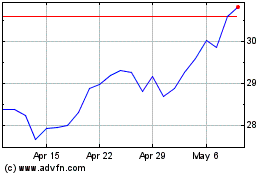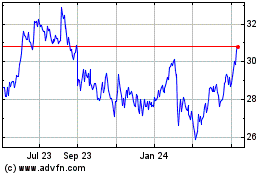Expected FCC ruling on audience caps could spark slew of media
deal making
By John D. McKinnon and Joe Flint
WASHINGTON -- Federal regulators plan to reverse an Obama-era
rule that prevented major television-station owners from buying
stations or readily selling themselves, a move that could touch off
a wave of deals among media companies.
The proposal, which would effectively loosen a national cap on
audience share for station owners that the rule had tightened, is
scheduled to be put before the Federal Communications Commission in
late April, an agency official said. Chairman Ajit Pai is expected
to announce the plan on Thursday afternoon.
The longstanding ownership cap limits TV groups to a 39%
national audience share. But for years, the government said station
owners didn't have to fully count UHF stations in calculating their
share because UHF was typically a less powerful signal. The
Obama-era FCC eliminated the so-called UHF discount last September,
contending that the distinction between UHF stations and VHF
stations had effectively disappeared.
The FCC under Mr. Pai is expected to revert to the previous rule
in one of a series of actions he is taking as he plans to reverse
several policies adopted under his predecessor, Tom Wheeler, who
was FCC chairman for much of President Barack Obama's second
term.
TV station owners have contended that fully counting the UHF
channels unfairly penalized them at a time when other types of
media have been growing rapidly.
One CBS Corp. executive, Anne Lucey, complained in recent
meetings with FCC officials that "our industry has been frozen in
time" by the Obama-era rule, according to regulatory filings.
Meanwhile, "our video competitors have marched on unfettered by
ownership limits," she said. CBS and some other media companies
asked the commission to reinstate the UHF discount, without waiting
to launch a broader proceeding on media-ownership issues.
21st Century Fox, which shares ownership with The Wall Street
Journal, challenged the Obama-era change in the U.S. Circuit Court
of Appeals for the D.C. Circuit, although the case has been on hold
while the FCC weighs what to do.
Despite that challenge, CEO James Murdoch recently indicated
that the company doesn't have a "big appetite" to add more stations
should the ownership regulations change.
Independent TV company Sinclair Broadcast Group Inc. has urged
the commission to get rid of the national cap entirely.
"Television stations face increased national competition from a
host of new services," including satellite and cable networks as
well as internet providers, Sinclair said in a recent filing. "The
national cap is simply no longer justified in today's media
environment."
A coalition of consumer groups including Free Press has opposed
the rollback. "Reversing the rule will allow these large group
owners to grow larger" and make acquisitions harder for new
entrants and smaller companies, said Andrew Schwartzman, a
Georgetown University law professor who represents the
coalition.
For independent station owners like Sinclair, growing through
acquisitions gives them more clout to negotiate lucrative carriage
deals with cable providers. It also ensures they can hold their own
in their affiliate relationships with national networks that supply
their key programming, such as ABC, CBS, NBC and Fox. The parent
companies of several of the big broadcasters also own some of their
own stations, and buying more is a way to reduce the leverage of
the independent groups.
The reinstatement of the UHF discount would give many
broadcasters room to grow. Sinclair would see its current 38% share
drop to 24% with the discount applied. Nexstar Media Group Inc.'s
39% attribution would decline to 26%, and Tegna Inc. would fall
from 32% to 27%.
Speaking on an earnings call last month, Tegna Media President
Dave Lougee said changes to the ownership rules would be "a very
good and overdue development for Tegna and the industry overall."
Nexstar Chief Executive Perry Sook told investors and analysts last
month that the company is "already in discussions should the rules
change about opportunities that might be available to us."
CBS, which owns stations with an audience share of 38%, would
also be able to become a buyer with the discount reducing its reach
to around 25%. CBS CEO Leslie Moonves told analysts earlier this
month that the company would welcome deregulation.
"I can tell you in the right circumstance if the cap is lifted
we would strategically want to buy some more stations because we
think it is important," Mr. Moonves said.
A deal that many analysts and industry executives are
anticipating is Sinclair acquiring Tribune Media Co., whose
national reach of 44% would fall to 26%. Wells Fargo Securities
analyst Marci Ryvicker in a recent report that such a purchase is
"complicated but possible."
Sinclair-Tribune combination would create a broadcasting
behemoth of more than 200 local stations. Sinclair operates 173 TV
stations, while Tribune owns or operates 42. Sinclair has a market
cap of $4.1 billion, and Tribune's market cap is $3.2 billion.
Even with the reduced ownership reach that a UHF discount would
bring, the combination would still likely require some stations to
be sold off to keep in line with the 39% cap. Tribune exceeds the
current 39% cap because its reach grew when the UHF discount was
eliminated and the company was granted a waiver.
Sinclair and Tribune have declined to comment.
Besides Tribune, few potential sellers have emerged. "We see
more buyers vs. sellers," Ms. Ryvicker said.
While the return of the UHF discount will likely lead to some
deals, television executives are also pining for a relaxation of
the rules that limit the number of television stations one
broadcaster can own in a market.
Currently, one company can own two TV stations in a market only
if eight independent TV stations remain afterward. That limits such
possibilities to big and midsize markets and leaves out smaller
markets where many TV stations are economically challenged,
broadcasters say.
Nexstar's Mr. Sook has told investors the company wants to
"pursue opportunities to grow our scale within local markets" and
would be "appropriately aggressive on that front."
Such changes would have to wait until later in the year, when
the FCC appears likely to take up other changes to its
media-ownership rules.
Another rule change that would significantly lead to more deals
and consolidation would be removing or relaxing the 39% cap itself,
although that may not be in the agency's purview.
Republican FCC Commissioner Michael O'Rielly wrote in a 2016
rule-making procedure that Congress, not the commission, has the
authority to alter the cap. Mr. O'Rielly said the cap is one of a
handful of media-ownership rules exempted from the FCC's
Quadrennial Review process in which the agency decides which
regulations are still necessary and which should be changed or
eliminated.
Write to John D. McKinnon at john.mckinnon@wsj.com and Joe Flint
at joe.flint@wsj.com
(END) Dow Jones Newswires
March 30, 2017 02:47 ET (06:47 GMT)
Copyright (c) 2017 Dow Jones & Company, Inc.
Fox (NASDAQ:FOX)
Historical Stock Chart
From Mar 2024 to Apr 2024

Fox (NASDAQ:FOX)
Historical Stock Chart
From Apr 2023 to Apr 2024
